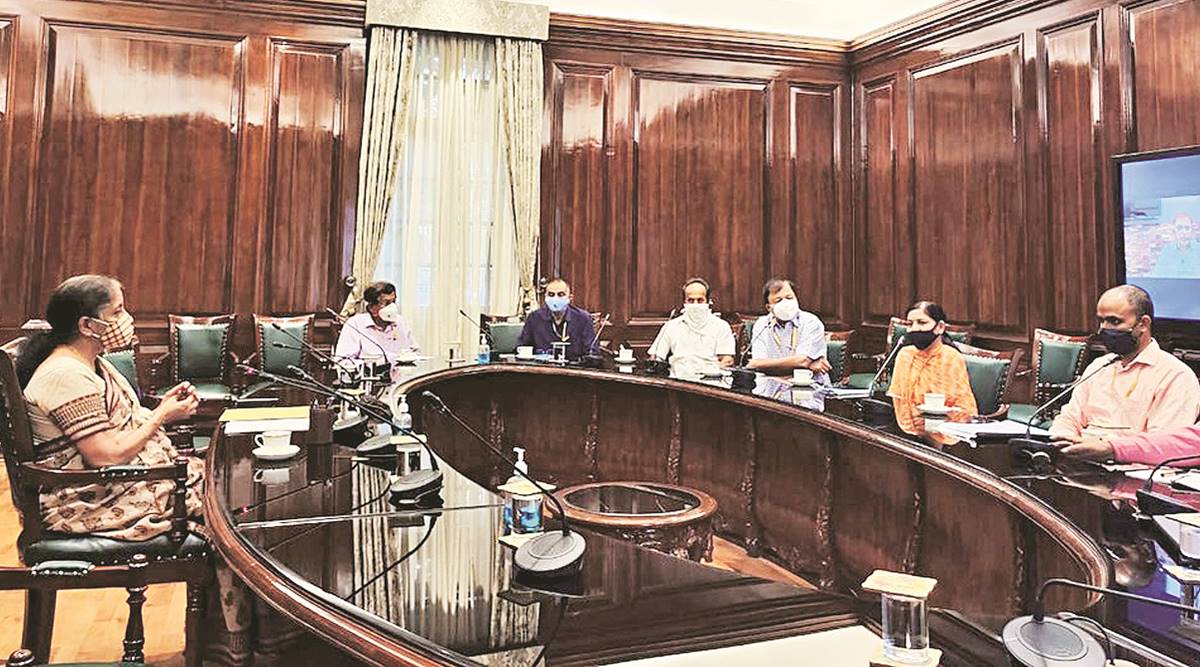 Minister of Finance and Corporate Affairs Nirmala Sitharaman with Directors and Deputy Secretaries of Department of Expenditure, in New Delhi Wednesday. (ANI)
Minister of Finance and Corporate Affairs Nirmala Sitharaman with Directors and Deputy Secretaries of Department of Expenditure, in New Delhi Wednesday. (ANI) WHILE THE government has announced a Rs 20 lakh crore stimulus package to counter the economic impact of Covid-19, official data shows that the Centre’s total expenditure in April-July increased by about Rs 1.07 lakh crore, or about 11.3 per cent — up from Rs 9.47 lakh crore in April-July last year to Rs 10.54 lakh crore this year. Much of this expenditure was on revenue account like payment of salaries and other regular expenses.
In the wake of record GDP contraction, experts, including the Reserve Bank of India (RBI), noted that a government-led spending push is needed for revival of the economy. So far, the government has tried to address supply side issues, but a booster dose is needed to stimulate demand, they said. Resources for such spending should be raised through aggressive asset monetisation and stake sale in state-owned companies.
“An expansion of 0.5 per cent of GDP in government spending (or Rs 1 lakh crore), when GDP has contracted by 24 per cent, is grossly disproportionate and a big push is needed to revive the economy. While income support for the poor was the primary objective during the initial phases of the lockdown, with the economy opening over the last two-three months, the government needs to push spending up on a war footing for revival,” said a top government policy advisor who did not want to be named.
Explained Ideas | Why merely more govt spending will not help Indian economy
The Rs 20 lakh crore Atma Nirbhar Bharat package relied on liquidity measures injected by the RBI, cash transfers to the poor and needy, as well as medium term structural measures. But the fiscal push has been small.
According to the latest data released by the Finance Ministry, “(during April-July 2020), total expenditure incurred by the Government of India is Rs 10,54,209 crore, of which Rs 9,42,360 crore is on revenue account and Rs 1,11,849 crore is on capital account. Of the total revenue expenditure, Rs 1,98,584 crore is on account of interest payments and Rs 1,04,638 crore is on account of major subsidies.”
This level of spending may not be enough to pull the economy out of a slump that may get prolonged.
“Of the relief package, only Rs 2.1 lakh crore was the expenditure to stimulate demand, and that too over the full year.
The government needs to put more money in the pocket of the consumer, and it should not be in the form of tax cuts. People at the bottom of the pyramid are affected, and a consumption boost is needed,” said D K Pant, chief economist at India Ratings and Research.
Even the RBI, in its Annual Report 2019-20 released last month, noted that investment activity has further weakened, and suggested “targeted public investment” funded by asset monetisation and privatisation of major ports to revive the economy.
Investment activity, as measured by Gross Fixed Capital Formation, contracted by nearly 47 per cent during the April-June quarter.
“We need spending from the government, and immediate spending should be aimed at something that puts cash in the hands of people who will spend it and not save it, and that will sustain employment levels. They must also spend massively on infrastructure as it is valuable investment in the long run. It will be a huge confidence booster and could turn the whole gear,” said Naushad Forbes, co-chairman of Forbes Marshall and former president of CII.
“Divestment and borrowing can be used to fund expenditure. The government should be privatising in a massive manner, including the public sector banks, and the starting point should be to come to 49 per cent. The moment you do that, the share value will shoot up, and then keep selling more at higher valuations, as you need. Also, if the government borrows to invest in infrastructure assets, I think it is much more reasonable and sensible,” Forbes said.
Sources said the additional Rs 1 lakh crore of spending by the government during April-July was on food distribution, income support and higher spend on rural employment guarantee scheme.
“Half of the relief announced came from RBI and Rs 1.7 lakh crore (and additional Rs 90,000 crore) was through food distribution. However, it is important to note that the government’s subsidy expenditure has come down on food, fertiliser and fuel and it got substituted by the relief measures announced during Covid. And that is the reason that the rise in expenditure in April-July 2020 does not seem significant over that in the corresponding period last year,” said Madan Sabnavis, chief economist at CARE Ratings.
“However, currently, when the private sector and others can’t spend, the extent of expenditure needed from the government is much more, and they should do that. While most of the issues are being addressed on the supply side, what is required is creation of demand, and that is where the focus should be,” he said.
Finance Ministry officials have maintained that they will take measures going forward as the impact of the pandemic will require regular intervention. The government held several discussions last month on pushing infrastructure spending to revive the economy.